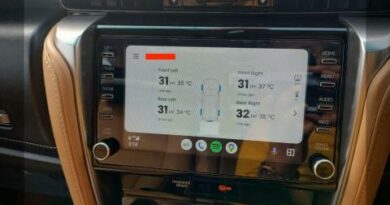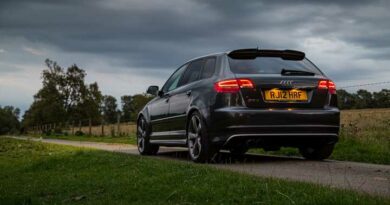Frontline MG BEE GT | PH Review
Frontline making a brilliant V8 MG shouldn't have been a surprise – what can it do with a plug-in EV?
By Matt Bird / Monday, 16 October 2023 / Loading comments
We’re all doing a lot of soul-searching right now when it comes to the future of the performance car. There’s a huge amount to think about, and no great consensus on any of it. Is ditching a combustion engine for electric sacreligious, or the saviour of classic cars which might otherwise pass into obsolescence? Can an electric version ever offer up a properly entertaining driving experience? Is synthetic fuel a red herring or a golden ticket? Where not so long ago you merely chose the convenience of a new car or the charm of an old one, now the lines are blurred. And the arguments for and against more impassioned.
Complicating – or perhaps clarifying – matters further is the Frontline MG BEE, or B EV Edition. It brings together all the chassis, braking and interior upgrades we’ve come to expect from a Frontline B build (this very car was an LE50 in a previous life) with an electric motor. A Hyper9 100v motor, in fact, powered by a 40kWh battery nestled under the bonnet where a Duratec would have sat in the early 2010s. So far, so EV transplant. Where the BEE differs is that the motor is hooked up to the five-speed manual gearbox from a Mazda MX-5. We’re already in the era of cars like the Ioniq 5 N simulating paddleshift gearchanges, but here’s an MG B with an electric motor under the bonnet, a manual in the middle, and a charge port by the chrome bumper at the back. It’s totally baffling, truth be told, and more than a little intriguing.
Additionally, the torque delivery of the motor has been tuned so that it delivers more of its performance further up the rev range, nearer its 9,000rpm maximum, rather than dumping everything it has on you at the merest hint of throttle. It’s been designed to encourage running out every gear in the most traditional sense. By the standards of these things, too, it sounds a relatively simple conversion, with the flywheel of the electric motor allied to that of the gearbox and, hey presto, manual EV. (If that undersells it, please fire away with questions and we’ll get some answers.) From the press release, there’s this from Tim Fenna, Frontline’s Founder and Chief Engineer: “We resisted conventional EV conversion despite the demand until we were able to deliver a vehicle that delivered the Frontline drive and ethos, a vehicle that feels engaging and a pleasure to drive without compromise, yet meeting modern environmental changes, the result impressed even us, retaining the gearbox and carefully tuned electric motor delivering experience akin to a normal ICE car, I absolutely love it. The BEEs are so engaging and fun to drive with so much character and feedback, they are an absolute joy to drive, I never want to get out of them.”
In the driver’s seat, the BEE feels very, well, B. You even need to crank the key in the central barrel for a couple of seconds to get it whirring into life. Where once there was a rev counter there’s now a power gauge that works in much the same way (change up when the needle is pointing to 4pm!) and a charge level where a fuel gauge once lived. There are three pedals offset to the right, a gearlever in close proximity to the wheel, and every smart fixture and fitting that might be expected of a restomod like this. Only accompanied by the faint buzz of a motor rather than the rumble of an engine.
The BEE is a strange car initially. While the clutch is used when moving (including for throttle-matched downshifts!) it isn’t required to get going or when coming to a stop. It can move away in any of the first three gears, so any concerns about this nullifying the advantages of an EV around town need not worry – just leave it in third and it’s a two-pedal car up to cruising speed. Despite moving off in first gear without a clutch, this is immediately and very evidently not the conventional electric vehicle experience, not least because the driver can hear so much of the experience. There’s whirring and grinding and chuntering, the kind of authentic drivetrain noises that we love to hear from driver-focused cars. Just no engine. It’ll even punish you with a bunny hop at low speed if however many decades of muscle memory dips the clutch. There’s not much creep, either, so more throttle is required for manouevring than your brain will say is appropriate.
It’s no less strange to hear the revs of a motor build in an EV, come off the throttle, dip the clutch, select the next gear and feel them drop again as it would in an ICE car. First and second here feel quite close, so it doesn’t really matter which the BEE starts in. But from there it’ll need third, fourth and fifth like any other manual. Helps no end that the feel of the sprung ceramic paddle clutch and five-speed is brilliant.
When the Frontline team suggested that it’s possible to hear when to change up right at the limiter, it was much easier to take their word for it than fully understand. But they’re onto something. The sound moves from a buzz into a fizzy wail over the final few revs, as if Mario’s Kart was rotary-powered. Perhaps not as stimulating as a rorty four-cylinder or thunderous V8, but not without its own appeal. Particularly as it’s the actual noise of motors and gears as opposed to something made up by marketing.
You really must heel-and-toe it, too, or the downshifts will be clumsy and jerky. It takes some learning, with the pedals canted right and a whole new ‘engine’ to get used to. But it works like any other: blip too much and the flare of revs is plain to hear (even if the gear goes in smoothly enough) while bringing the clutch up too soon will have the powertrain stumble as things don’t quite mesh right. Get your footwork right, though, and there’s the joy of a throttle-matched downshift to savour.
There’s so much more to the experience than just the EV novelty, too. It’s still a Frontline build, so it corners, rides and stops just beautifully; crucially for a sense of driver involvement it’s not infallible, either, because there’s no way of getting batteries buried in the bottom of a B. Drive it like a well-sorted, front-engined, rear-drive classic and it behaves like one, steering nicely keyed in and limited-slip diff just helping cornering attitude if required. This is one of those rare EVs, in fact, that could do with a little more muscle to tax its chassis; an LE50 was around 215hp, while Frontline only suggests the BEE is 120hp strong, with 162lb ft. More will follow for production spec, so it says a lot that this is already so enjoyable.
Not for nothing, but for anyone already tired of supersonic EVs, the Frontline will be a tonic – not least because it requires effort to extract the performance. It’s a sports car that demands to be driven, and rewards in kind, only it’s powered by electricity. We wondered whether it would be one of the big OEMs that delivered an electric car that could genuinely raise a smile; turns out first to the punch is a small MG specialist in Oxfordshire. Never has an EV charmed or appealed like this one, all with an 8.8-second 0-60mph time. Like many an old car, it needs effort to keep up with traffic and prefers smaller roads to dual carriageways – plus the sense of occasion is enormous – only it could, in theory, spend its life from now on powered by renewable energy.
There are issues, mind. For the moment, the BEE has a range of 140 miles and can only accept 7kW charging. So it’s one to rejuice at home and enjoy early morning blasts (and maybe commutes) in, rather than use as a long-distance companion. Needless to say, a production version will go faster and further. As per all these conversions, too, it seems unlikely that an EV swap will be any more affordable than getting a 7,000rpm+ Duratec allied to the manual. And that’s perhaps where the case for the BEE comes unstuck just a tad. Because if you’re after the old car experience, with rev-matching and redlines and Sunday morning thrashes, why not have it with an engine onboard? A 2.5-litre MG B used during the summer months is no more going to ruin the planet than a battery-powered one is going to save it. And even after a wholly positive experience with the BEE, it’s not hard to imagine what the PH preference might be when spending a lot of money on an MG.
Nevertheless, Frontline deserves enormous credit for what it’s created with the B EV Edition. Even at the prototype stage, it’s a functional, entertaining, engaging electric sports car, one that answers many questions we all had (while posing a good few more). Never before has an EV felt this compelling; it’s a genuinely fun to drive little car because of its new powertrain, not despite it. Frontline says there’s more performance and more range to come for those customers who have orders in (think 200hp/200 miles), and another longer drive really can’t come soon enough. Nobody really knows what the future holds for old cars, but if it’s in the hands of companies like Frontline then we need not be concerned. This is a very auspicious start for the electric manual restomod.
SPECIFICATION | FRONTLINE MG BEE GT PROTOTYPE
Engine: 40kWh battery, Hyper9 100v motor
Transmission: 5-speed manual, rear-wheel drive
Power (hp): 120hp
Torque (lb ft): 162
0-62mph: 8.8 seconds
Top speed: 120mph
Weight: 1,186kg (dry)
MPG: c. 140 miles range, 5.5 hours charge via 7kW plug
CO2: 0g/km (driving)
Price: from £144,000
- Time to appreciate the MG B LE60 in all its glory
- Everrati 911 Signature Wide Body | PH Review
Source: Read Full Article



